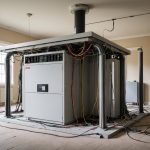Older electrical systems can be a barrier to experiencing the benefits of smart home technology. Retrofitting your Derby home not only enhances convenience but also boosts energy efficiency and security. This guide explores practical steps for upgrading your outdated wiring and integrating smart solutions seamlessly. Discover how you can transform your living space into a modern haven while preserving its unique charm. Embrace this change and unlock your home's full potential with ease and confidence.
Understanding the Basics of Retrofitting Electrical Systems
Retrofitting electrical systems is an essential process for bringing older infrastructures up to modern standards. This practice not only enhances safety but also improves energy efficiency. By integrating smart home technology, homeowners can enjoy a more connected and efficient living environment.
A lire en complément : Transform Your Suburban UK Home: A Comprehensive Guide to Installing a Greywater Recycling System
The primary goal of retrofitting is to update existing electrical systems without the need for a complete overhaul. This can include replacing outdated wiring, upgrading circuit breakers, or installing new outlets to support modern appliances. The importance of retrofitting lies in its ability to extend the lifespan of a building's electrical infrastructure while accommodating the growing demand for electricity in today's tech-driven world.
One of the significant benefits of modernizing electrical systems is the seamless smart home integration it enables. With the addition of smart devices, homeowners can automate lighting, heating, and security systems. This not only enhances convenience but also contributes to energy savings by optimizing electricity usage based on real-time data.
A lire en complément : Transform Your UK Home: Embrace Sustainable and Eco-Friendly Decor Solutions!
Key components of smart home technology include smart thermostats, lighting controls, and home security systems. These devices communicate with each other and can be controlled remotely, offering a level of customization and control previously unattainable. By retrofitting electrical systems to support these technologies, homeowners can enjoy a more efficient and responsive home environment.
Assessing Your Current Electrical System
Before embarking on a retrofitting journey, conducting a comprehensive electrical assessment is crucial. This process involves a detailed home inspection to identify outdated wiring and components that may compromise safety and efficiency.
Steps to Conduct a Thorough Assessment
-
Visual Inspection: Begin by examining visible wiring, outlets, and circuit breakers. Look for signs of wear, such as fraying or discolouration, which may indicate potential hazards.
-
Testing Electrical Components: Use appropriate tools to test outlets and switches for functionality. Ensure that circuit breakers are operating correctly and are not frequently tripping, as this could signal an overload.
-
Identifying Outdated Wiring: Pay attention to older wiring types, such as knob-and-tube or aluminium wiring, which may not meet current safety standards. These can pose significant risks and should be replaced with modern alternatives.
Importance of Working with a Qualified Electrician
While some aspects of the assessment can be done independently, it is essential to work with a qualified electrician. Their expertise ensures a thorough evaluation and accurate identification of potential issues. Electricians can also recommend suitable upgrades and ensure all work complies with local electrical codes. By prioritising safety and efficiency, homeowners can confidently proceed with retrofitting their electrical systems.
Planning Your Retrofit Project
Embarking on a retrofit project requires meticulous project planning to ensure a smooth transition to an upgraded electrical system. A comprehensive plan begins with identifying the specific needs of your home and determining which smart home devices will best meet these requirements. Selecting compatible devices is crucial, as they must integrate seamlessly with your existing infrastructure.
When choosing smart home devices, consider their compatibility with each other and the central control system. This ensures that devices like smart thermostats, lighting controls, and security systems work harmoniously, providing an efficient and automated home environment. Researching and consulting with professionals can help you make informed decisions.
Budgeting is another critical aspect of planning your retrofit project. Start by estimating the costs associated with upgrading your electrical system and integrating smart technology. This includes expenses for new wiring, devices, and professional installation services. Creating a detailed budget helps manage finances effectively and prevents unexpected costs.
- Smart Home Devices: Choose devices that offer long-term energy savings.
- Budgeting: Allocate funds for potential unforeseen expenses.
- Project Planning: Set realistic timelines for each phase of the project.
By carefully planning and budgeting, homeowners can achieve a successful retrofit project, enhancing both safety and convenience.
Tools and Materials Needed for Retrofitting
When embarking on an electrical retrofit project, having the right retrofitting tools and electrical materials is crucial for efficiency and safety. These tools and materials ensure that the project is conducted smoothly and meets modern standards.
Essential Tools for Electrical Retrofit Projects
A successful retrofit requires a variety of tools. A voltage tester is indispensable for ensuring circuits are de-energised before work begins. Wire strippers and cutters are necessary for handling and preparing wires. Additionally, a multimeter is useful for measuring voltage, current, and resistance, providing valuable insights into your electrical system's performance. These tools help maintain safety and precision throughout the project.
Recommended Materials for Safety and Efficiency
Selecting the right electrical materials is key to a successful retrofit. Opt for high-quality wiring and circuit breakers that comply with current safety standards. Consider using energy-efficient lighting and smart switches to enhance your home's efficiency. These materials contribute to a safer and more energy-conscious environment.
Where to Source Quality Supplies in Derby
In Derby, sourcing DIY supplies is convenient with several reputable hardware stores and electrical supply shops available. These outlets offer a wide range of tools and materials, ensuring you find everything needed for your retrofit project.
Step-by-Step Guide to Retrofitting
Embarking on an electrical upgrade requires careful planning and execution. This guide outlines the key retrofitting steps to ensure a successful installation.
Preparing the Workspace
Before beginning any installation, ensure the workspace is organised and safe. Clear the area of any obstructions and ensure you have easy access to all necessary tools and materials. It's crucial to disconnect power to the area you will be working on to prevent accidents. Use a voltage tester to confirm that circuits are de-energised.
Removing Old Wiring and Components
Begin by carefully removing outdated wiring and components. Use wire strippers and cutters to safely detach old wires. Ensure all circuit breakers are turned off to avoid electrical hazards. It's important to handle all components with care to prevent damage to existing structures.
Installing New Smart Home Devices
With the old components removed, proceed with installing new smart home devices. Follow the manufacturer's installation guide for each device to ensure proper setup. Pay attention to the compatibility of devices with your existing system. Safety precautions, such as wearing insulated gloves, are vital during this phase. Maintain the aesthetics of your home by neatly arranging wires and devices, ensuring they blend seamlessly with your decor.
Integrating Smart Home Technology
Incorporating smart home integration into your retrofit project offers numerous advantages, from enhanced convenience to improved energy efficiency. A critical first step is ensuring compatibility with your existing systems. This involves evaluating your current electrical setup and selecting devices that can seamlessly communicate with one another. Compatibility ensures that all components, such as smart thermostats and lighting controls, work harmoniously, creating a cohesive and efficient smart home environment.
Automation Options Available
Smart home automation provides a wide array of options to enhance your living experience. Homeowners can automate lighting, heating, and even security systems, tailoring each to their specific needs and preferences. Automation not only simplifies daily tasks but also optimises energy consumption by adjusting settings based on real-time data and usage patterns. This intelligent approach to managing home systems can lead to significant energy savings and increased comfort.
Recommended Smart Home Platforms for Derby Homes
For residents in Derby, selecting the right smart home platform is essential for a successful integration. Popular platforms like Google Home, Amazon Alexa, and Apple HomeKit offer robust solutions with a range of compatible devices. These platforms support various automation features, enabling homeowners to control and monitor their systems through voice commands or mobile apps, ensuring a streamlined and user-friendly experience.
Safety Considerations During Retrofitting
When undertaking a retrofit project, prioritising electrical safety is paramount. Ensuring compliance with local electrical codes and regulations is essential to mitigate risks and guarantee a safe environment. These codes provide guidelines on the correct handling and installation of electrical components, protecting both the installer and the household.
Importance of Compliance
Adhering to electrical codes is not just a legal requirement but a crucial safety precaution. Non-compliance can lead to severe consequences, including electrical fires and equipment damage. Therefore, always verify that all retrofitting activities meet the current standards.
Tips for Safe Handling
When working with electrical components, certain precautions are necessary to prevent accidents. Always de-energise circuits using a voltage tester before commencing work. Wear appropriate personal protective equipment, such as insulated gloves, to minimise the risk of electric shock. Ensure tools are in good condition to avoid malfunctions.
Common Safety Pitfalls
Avoiding common safety pitfalls is vital during retrofitting. One frequent mistake is neglecting to double-check connections, which can lead to shorts or faulty circuits. Additionally, overloading circuits with too many devices can cause overheating and potential hazards. Always plan the electrical load distribution carefully to maintain a balanced and safe system.
Troubleshooting Common Issues
Retrofitting can occasionally present electrical problems that require immediate attention. Identifying these issues early is crucial to implementing effective solutions.
Identifying Common Retrofit Issues
Several issues may arise during a retrofit project. One frequent problem is faulty wiring, which can lead to inconsistent power supply or tripped circuit breakers. Additionally, incorrect installation of smart home devices can result in connectivity issues or device malfunctions. It's essential to double-check all connections and ensure devices are compatible with your existing system.
Resolving Electrical Problems
To resolve these electrical problems, start by using a multimeter or voltage tester to identify any inconsistencies in power delivery. Ensure all wiring and connections are secure and correctly installed. For smart devices, verify that they are properly configured and compatible with your network.
When to Seek Professional Help
If issues persist despite troubleshooting efforts, it may be time to seek professional assistance. A qualified electrician can provide expert insights and ensure that your retrofit project complies with safety standards and regulations. Their expertise is invaluable in resolving complex problems that may be beyond a homeowner's capability.
Resources for Additional Troubleshooting Support
For further support, consult reliable resources such as manufacturer guidelines, online forums, or professional electrician services. These resources can offer valuable advice and solutions to common retrofit challenges, ensuring a successful project completion.
Working with Local Contractors
When embarking on a retrofitting project, selecting the right local contractors is crucial. Their expertise and knowledge of professional services can significantly impact the success of your project.
How to Choose the Right Contractor
Begin by researching potential local contractors. Look for those with a solid reputation and positive reviews. Recommendations from friends or family can provide valuable insights. Ensure the contractor is licensed and insured, which guarantees a level of professionalism and accountability.
Questions to Ask During Contractor Interviews
During interviews, ask about the contractor's experience with similar projects. Inquire about their familiarity with smart home technology and their approach to integrating these systems. It's also important to discuss timelines and budgets to ensure alignment with your expectations. Understanding their process for handling unforeseen issues can provide peace of mind.
Benefits of Hiring Local Professionals
Hiring local contractors offers several advantages. They are familiar with local building codes and regulations, ensuring compliance. Additionally, local professionals often have established relationships with suppliers, which can expedite the procurement of necessary materials. Their proximity allows for easier communication and site visits, fostering a smoother project flow. By choosing the right contractor, you can confidently proceed with your retrofitting project, knowing you're in capable hands.











